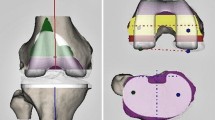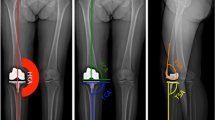Abstract
Purpose
In recent years, patient-specific instruments (PSI) has been introduced with the aim of reducing the overall costs of the implants, minimising the size and number of instruments required, and also reducing surgery time. The purpose of this study was to perform a review of the current literature, as well as to report about our personal experience, to assess reliability of patient specific instrument system in total knee arthroplasty (TKA).
Methods
A literature review was conducted of PSI system reviewing articles related to coronal alignment, clinical knee and function scores, cost, patient satisfaction and complications.
Results
Studies have reported incidences of coronal alignment ≥3° from neutral in TKAs performed with patient-specific cutting guides ranging from 6 % to 31 %.
Conclusions
PSI seem not to be able to result in the same degree of accuracy as the CAS system, while comparing well with standard manual technique with respect to component positioning and overall lower axis, in particular in the sagittal plane. In cases in which custom-made cutting jigs were used, we recommend performing an accurate control of the alignment before and after any cuts and in any further step of the procedure, in order to avoid possible outliers.


Similar content being viewed by others
References
Jeffery RS, Morris RW, Denham RA (1991) Coronal alignment after total knee replacement. J Bone Joint Surg Br 73(5):709–714
Perillo-Marcone A, Barrett DS, Taylor M (2000) The importance of tibial alignment: finite element analysis of tibial malalignment. J Arthroplasty 15(8):1020–1027
Lützner J, Dexel J, Kirschner S (2013) No difference between computer-assisted and conventional total knee arthroplasty: five-year results of a prospective randomised study. Knee Surg Sports Traumatol Arthrosc 21(10):2241–2247
Hoffart HE, Langenstein E, Vasak N (2012) A prospective study comparing the functional outcome of computer-assisted and conventional total knee replacement. J Bone Joint Surg Br 94(2):194–199
Chin PL, Yang KY, Yeo SJ, Lo NN (2005) Randomized control trial comparing radiographic total knee arthroplasty implant placement using computer navigation versus conventional technique. J Arthroplasty 20(5):618–626
Conteduca F, Iorio R, Mazza D, Caperna L, Bolle G, Argento G, Ferretti A (2012) Are MRI-based, patient matched cutting jigs as accurate as the tibial guides? Int Orthop 36(8):1589–1593
Conteduca F, Iorio R, Mazza D, Caperna L, Bolle G, Argento G, Ferretti A (2013) Evaluation of the accuracy of a patient-specific instrumentation by navigation. Knee Surg Sports Traumatol Arthrosc 21(10):2194–2199
Victor J, Dujardin J, Vandenneucker H, Arnout N, Bellemans J (2013) Patient-specific guides do not improve accuracy in total knee arthroplasty: a prospective randomized controlled trial. Clin Orthop Relat Res. 2013 Apr 25. [Epub ahead of print]
Thienpont E, Bellemans J, Delport H, Van Overschelde P, Stuyts B, Brabants K, Victor J (2013) Patient-specific instruments: industry's innovation with a surgeon's interest. Knee Surg Sports Traumatol Arthrosc 21(10):2227–2233
Conteduca F, Massai F, Iorio R, Zanzotto E, Luzon D, Ferretti A (2009) Blood loss in computer-assisted mobile bearing total knee arthroplasty. A comparison of computer-assisted surgery with a conventional technique. Int Orthop 33(6):1609–1613
Iorio R, Bolle G, Conteduca F, Valeo L, Conteduca J, Mazza D, Ferretti A (2013) Accuracy of manual instrumentation of tibial cutting guide in total knee arthroplasty. Knee Surg Sports Traumatol Arthrosc 21(10):2296–2300
Iorio R, Mazza D, Bolle G, Conteduca J, Redler A, Conteduca F, Ferretti A (2013) Computer-assisted surgery: a teacher of TKAs. Knee 20(4):232–235
Bali K, Walker P, Bruce W (2012) Custom-fit total knee arthroplasty: our initial experience in 32 knees. J Arthroplasty 27(6):1149–1154
Pietsch M, Djahani O, Hochegger M, Plattner F, Hofmann S (2013) Patient-specific total knee arthroplasty: the importance of planning by the surgeon. Knee Surg Sports Traumatol Arthrosc 21(10):2220–2226
Chen JY, Yeo SJ, Yew AK, Tay DK, Chia SL, Lo NN, Chin PL (2013) The radiological outcomes of patient-specific instrumentation versus conventional total knee arthroplasty. Knee Surg Sports Traumatol Arthrosc. 2013 Aug 31. [Epub ahead of print].
Nam D, Maher PA, Rebolledo BJ, Nawabi DH, McLawhorn AS, Pearle AD (2013) Patient specific cutting guides versus an imageless, computer-assisted surgery system in total knee arthroplasty. Knee 20(4):263–267
Boonen B, Schotanus MG, Kerens B, van der Weegen W, van Drumpt RA, Kort NP (2013) Intra-operative results and radiological outcome of conventional and patient-specific surgery in total knee arthroplasty: a multicentre, randomized controlled trial. Knee Surg Sports Traumatol Arthrosc 21(10):2206–2212
Parratte S, Blanc G, Boussemart T, Ollivier M, Le Corroller T, Argenson JN (2013) Rotation in total knee arthroplasty: no difference between patient-specific and conventional instrumentation. Knee Surg Sports Traumatol Arthrosc 21(10):2213–2219
Daniilidis K, Tibesku CO (2013) A comparison of conventional and patient-specific instruments in total knee arthroplasty. Int Orthop. 2013 Jul 31. [Epub ahead of print]
Vundelinckx BJ, Bruckers L, De Mulder K, De Schepper J, Van Esbroeck G (2013) Functional and radiographic short-term outcome evaluation of the Visionaire system, a patient-matched instrumentation system for total knee arthroplasty. J Arthroplasty 28(6):964–970
Koch PP, Müller D, Pisan M, Fucentese SF (2013) Radiographic accuracy in TKA with a CT-based patient-specific cutting block technique. Knee Surg Sports Traumatol Arthrosc 21(10):2200–2205
Scholes C, Sahni V, Lustig S, Parker DA, Coolican MR (2013) Patient-specific instrumentation for total knee arthroplasty does not match the pre-operative plan as assessed by intra-operative computer-assisted navigation. Knee Surg Sports Traumatol Arthrosc. 2013 Sep 17. [Epub ahead of print]
Lustig S, Scholes CJ, Oussedik S, Kinzel V, Coolican MR, Parker DA (2013) Unsatisfactory accuracy with VISIONAIRE patient-specific cutting jigs for total knee arthroplasty. J Arthroplasty. 2013 Jul 25. [Epub ahead of print]
Daniilidis K, Tibesku CO (2013) Frontal plane alignment after total knee arthroplasty using patient-specific instruments. Int Orthop 37(1):45–50
Boonen B, Schotanus MG, Kort NP (2012) Preliminary experience with the patient-specific templating total knee arthroplasty. Acta Orthop 83(4):387–393
Ng VY, DeClaire JH, Berend KR, Gulick BC, Lombardi AV Jr (2012) Improved accuracy of alignment with patient-specific positioning guides compared with manual instrumentation in TKA. Clin Orthop Relat Res 470(1):99–107
Noble JW Jr, Moore CA, Liu N (2012) The value of patient-matched instrumentation in total knee arthroplasty. J Arthroplasty 27(1):153–155
Nunley RM, Ellison BS, Ruh EL, Williams BM, Foreman K, Ford AD, Barrack RL (2012) Are patient-specific cutting blocks cost-effective for total knee arthroplasty? Clin Orthop Relat Res 470(3):889–894
Mason JB, Fehring TK, Estok R, Banel D, Fahrbach K (2007) Meta-analysis of alignment outcomes in computer-assisted total knee arthroplasty surgery. J Arthroplasty 22(8):1097–1106
Klatt BA, Goyal N, Austin MS, Hozack WJ (2008) Custom-fit total knee arthroplasty (OtisKnee) results in malalignment. J Arthroplasty 23(1):26–29
Author information
Authors and Affiliations
Corresponding author
Rights and permissions
About this article
Cite this article
Conteduca, F., Iorio, R., Mazza, D. et al. Patient-specific instruments in total knee arthroplasty. International Orthopaedics (SICOT) 38, 259–265 (2014). https://doi.org/10.1007/s00264-013-2230-9
Received:
Accepted:
Published:
Issue Date:
DOI: https://doi.org/10.1007/s00264-013-2230-9




